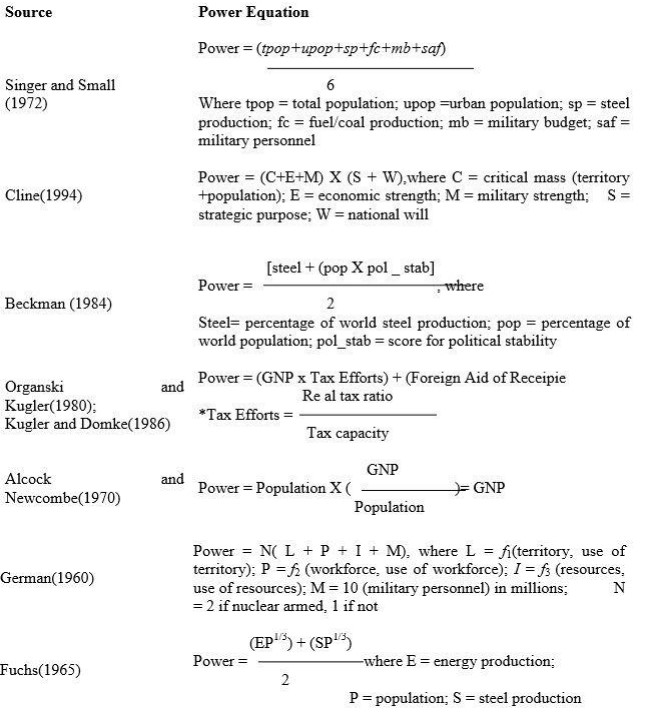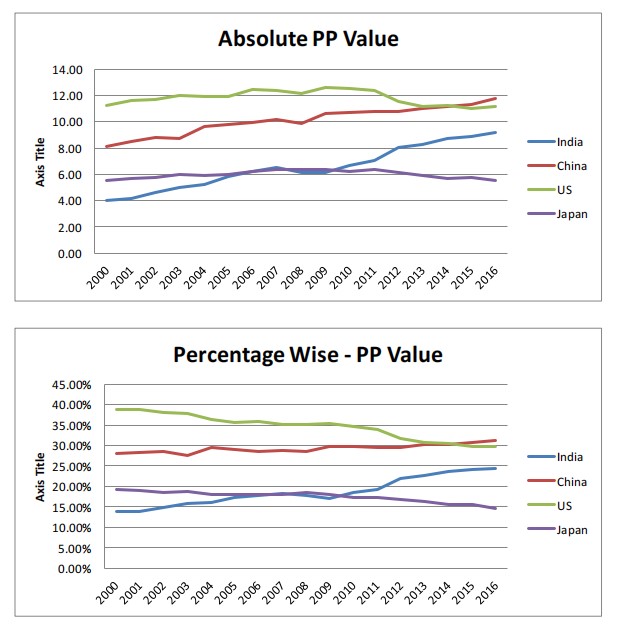Quantification of National Power, Power cycle, Theory and the China challenge
In closing passages of war & peace, Leo Tolstoy asks “What is Power?” This has been the most central question for International relation practitioners today
Power’s definition and role it plays in international relations can be seen in different ways by various international relations theories. Hans J. Morganthau and Robert Strausz saw international politics itself as the “Struggle for power”; Charles Kindleberger saw power as “Strength capable of being used efficiently “(Dougherty and Pfaltzgraff1990) A.F.K. Organski suggests that one of the most important characteristics of a nation is its power: for power is a major determinant of the role a nation play in the international system. He defines power as the “ability to influence the behavior of others in accordance with the one’s own ends” and warns against defining power as the use of force or violence alone (Organski 1968).
Power has figured importantly in discussions in international relations since time of Thucydides. Two principle approaches to power analysis in international interactions has been the ‘Power as resource’ approach and the ‘relational power’ approach
Since Joseph Nye’s three dimension chess board –military power, economic power and soft power dimension are taken into account while defining the strategic impetus. A number of efforts have been made by various scholars to quantify soft power using the published as well as primary source indicators like diplomacy sub index, government sub index, culture sub index, education sub – index, innovation sub – index etc. Rand Corporation sought to bring in non – state actors into power calculation.
Before one can measures power, one must first have a concept of power. In the field of international relations, the desire to measure power on a single dimension that would allow states to be ranked often gets in the way of – or even precedes conceptual analysis. Frey (1989) has pointed out that the difficulty of measuring power often leads researchers to redefine it so as to make operationalization easier. ‘In this fashion, power has frequently been defined in terms of supposed resource – e.g. the ability to mobilize resources, possession of resources, and other forms of what Elster (1976:252) calls “generalized fetishist theories,” that is, theories that attempt to regard relations as properties’ (Frey, 1989:7-8). Dahl (1984:21) identifies ‘confounding power with resources’ as a fallacy in power analysis, and another writer labels it as ‘the vehicle fallacy’ (Morriss, 2002:18-19).
Here, according to Baldwin, the methodology of measurement of power would depend upon the purpose of measurement.
There have previously, various attempts, being made to measure power
Such approaches include

In measuring the size of a nation, this study adopts Cline’s framework, which includes critical mass (territory and population), economic strength, and military strength. More specifically a For the analysis using Power Cycle theory, Cline’s method may be the most appropriate one.5 Which states, PP = (C + E +M) X (St+ W) Where, PP = Perceived Power, C = Critical Mass, Population, Territory E = Economic Power M = Military Capability St = Strategic Purpose W = Will to pursue National Strategy nation’s GNP and military expenditures are used to represent its economic and military strength. In addition, in measuring the degree of modernization, this study employs energy consumption per capita.
The results of cline’s power assessment are problematic, in part because his evaluation of intangible factors such as strategic purpose and national will relies heavily on subjective perception, and in part because his method of assigning weights to variables is too arbitrary to duplicate the outcome or obtain consistent result. Singer and Small’s method, which is consistent and duplicable, is used here instead to aggregate individual component into a power index. The composite method is as follows:
1. Use yearly aggregate statistics. Calculate the percentage share of the world sum for each variable item (except energy consumption per capita) for every country
2. For the additive components, assign a total score of 200 to critical mass (evenly divided for territory and population, i.e. a score of 100 for each), economic strength and military strength. The assigning of 200 as a total score is for calculation convenience
3. In the interactive model, construct an index of capacity, which serves as a power multiplier, by subtracting individual nation’s energy consumption per capita over the world average energy consumption per capita
4. Subtract the power score of the target nation over the power score of the sender (here, the United States) to generate a ratio index for relative capabilities
More specifically, three measures for national power are formulated as:

For the analysis using Power Cycle theory, Cline’s method may be the most appropriate one.5 Which states, PP = (C + E +M) X (St+ W)
Where,PP = Perceived Power
C = Critical Mass, Population, Territory
E = Economic Power
M = Military Capability
St = Strategic Purpose
W = Will to pursue National Strategy
The author feels Soft Power may also be included in this relationship and notes that, various attempts have been made successfully to quantify Soft Power in part, like the Soft Power 30 6 and New persuaders III. 7 Thus, the modified formula,
Pp = (aC +b E + c M +d S) X (St + w) Has been used, where a,b,c,d are the constants and S = Soft Power.
A. Measurement:
i. Using Delphi method, the values of constants were found to be a=1.31, b = 3.30, c = 4.21, d = 1.18
ii. C: is a factor of population, literacy, economic 8 power has been used.
According to this, Economic Power is a factor of
i. Revenue earned
ii. (a) Foreign Exchange Reserves (b) Export of goods and services iii. Measure of aggregate human capital.
Then,
iv. Sunmarines
v. Soft Power : Various attempt have been made to calculate & quantify Soft Power. The author here has used regression analysis and sub components and weightages have been derived using Delphi Technique
vi. Strategy purpose & will to Pursue strategy is based on expert opinions
Based on this perceived power has been calculated.
B. Power Cycle Theory: The foundation of state power, which power cycle theory stresses is National Capability relative to other states in the system.9 According to this theory, Structural uncertainty catalysis was at critical point. Major shifts of power between status occur infrequently and are rarely peaceful.10 In ‘Causes of war’, Evera states 11 a very specialized version of power shift : windows of opportunity where, relative Power shifts cause conflict. According to this literature, explanation for major wars lies in general rise and decline of states.12 For Doran passage through critical points provides a more robust explanation than power shifts for the onset of war.
C. Observations:
(a) Accordingly National Power has been computed and relative power is considered when system consists of U.S., China, India and Japan
(b) U.S. score in especially power, from 2013 till 2016 due to lack of willingness of pursuing national purpose
(c) 2016 becomes a critical year and extrapolation would show, by 2018, major conflicts between US –China, India – China will erupt though not war.
Conclusion:
(1) Japan has already peaked in relative Power terms, China will pass through an inflection point of slowing relative power growth.14 India would bridge the gap and U.S. would face relative decline as compared to China
(2) For China to enjoy ‘Peaceful rise’, it must contend with challenges of future systems transformation just as the other members of the system had in the past
(3) Other government must learn to preserve their security and interests while assisting China to trans this projected and particularly streeful interval future history.1
Limitations:
(1) Ideally there should have been long cycles.
(2) Only power cycle theory has been considered.

Bibliography
1. Overgaard, Jacob. ’Can soft power be measured and what it means to US’ –Bemidji State
2. Baldwin, David. “Power and international Relations’. Princeton education, 2016
3. Ibid
4. Chin – Lung Chang. ‘A measure of National Power’. Fo – guang University. 2014
5. Ray S. Cline, ‘Power Trends & US foreign policy’. Wiley com.2012
6. McClory, Jonathan. ‘Soft Power 30 Report’. Info @portland-communication Ltd.2015
7. McClory, Jonathan. ‘The new persuaders III’. Institute for Government, US. 2012
8. Kaushik Basu et al. ‘Evolving dynamics of global economic power in post crisis world’. International Institute Arrangements. 2011
9. Charles Doray. ‘System in Crisis’. Cambridge studies. 1991
10. James Hoge Jr. ‘Global Pwer shift in the making’. Foreign Affairs. 2004
11. Stephan Van Evera. ‘Causes of War’. Cornell University Press. 1999
12. Woosang Kim, James Marrao. ‘Why do power shifts lead to war’. American Journal of Political Science. 1992
13. Charls F. Dorani. ‘Power cycles or Power Shifts’. Internation Political Science Association, Chile.2009
14. Charles Doran. ‘Interpreting Chinas Rise’. The SAIS Journal of Global affairs. 2012
15. Zbigniew Brezinski. ‘Strategic Vision: American and the crisis of Global power’. Basic books, New York. 2011

